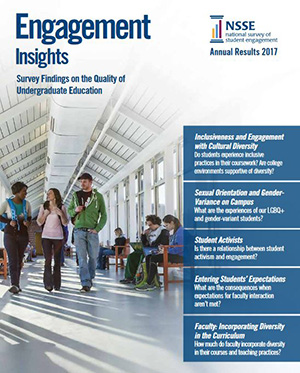For most of U.S. higher education's history, access to college was largely limited to White and male students from the upper rungs of the socioeconomic ladder. However, the last half-century has witnessed considerable expansion of higher education opportunities for women, historically underrepresented racial/ethnic groups, and students from modest socioeconomic backgrounds, and more recent years have seen a growing acceptance of other forms of diversity as well. Many colleges and universities are working to provide safe, welcoming, and educationally effective environments for students across a wide range of difference including gender identity, sexual orientation, and disability status. How well is higher education responding to the needs of such diverse student populations? Several analyses in NSSE's 2017 Annual Results, Engagement Insights: Survey Findings on the Quality of Undergraduate Education, bear on this important question.
In 2017, NSSE introduced the Inclusiveness and Engagement with Cultural Diversity Topical Module to examine environments, processes, and activities that embrace cultural diversity and promote greater understanding of societal differences. More than 55,000 students from 132 institutions answered questions about inclusive teaching practices, perceptions of institutional support for diverse students, and participation in diversity-related programming and coursework. Details include how often students' coursework emphasized inclusive and culturally engaging activities, how inclusive coursework relates to engagement, and how perceptions of institutional support for diversity vary by student characteristics.
Reflecting the heightened national attention to issues of racial equity, social justice, and political polarization, we also investigated political and social activism among today's college students. In addition, we examined the alignment of entering students' expectations for interaction with faculty during college with their actual experiences, and present intriguing results from a novel analysis of how faculty members allocate their time across the three principal domains of their professional activity: teaching, research, and service. See these stories and more, including examples from specific institutions of how they have put NSSE data to use, here.


